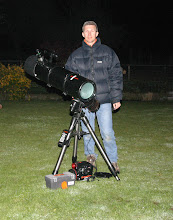It has been a while, but finally it’s a good night to observe. During the last week there were a couple of good nights, but I have been so busy at my work that in the evening I was not really in a good shape (and mental mood) to observe. Age is getting its effect on me.
But today (Saturday) we continue the Herschel II program. The counter is at 93 so hopefully we’ll reach 100 after this session.
Location: Boutersem (Belgium)
Equipment: Celestron Advanced Newton 20cm F5
Eyepieces: 24mm and 16mm - Powermate 2,5x
Limit Magnitude: 4.9
Seeing: moderate
Time: from 18:30 UT to 22:30 UT
Comet 46P/Wirtanen
But before observing the deepsky objects, let’s start first with a comet. Today comet 46P/Wirtanen goes through its perihelium. At 42x I can see an almost round smudge of 7’. A slightly brighter core is visible. The visibility enhances at 64x. The object reacts very well to a deepsky filter. Now the core is easily to see.
NGC 1663 – open cluster in Orion
This is a difficult object. It’s by the way not correctly located in my planetarium software. I had to search on the DSS image to indicate the correct location on my finder chart. At 154x I can see with averted vision some 5 to 10 starts in an area of 10’. It’s a loose cluster situated north of a little arc of 3 bright stars.
NGC 7762 – open cluster in Cepheus
At 64x I see 10 stars of moderate brightness in an area of 15’. It’s a very loose cluster. At 154x a small concentration of 5 stars (5’) is visible in the centre of the cluster.
NGC 7419 – open cluster in Cepheus
At 154x 4 stars are visible with averted vision at the east side of a triangle of 3 stars, of which one is quite bright. That one is slightly orange.
NGC 1184 – galaxy of 12.4 in Cepheus
At 104x it’s once in a while visible with averted vision. It’s an elongated smudge of 2’ in the direction NW-SE. No core. The galaxy becomes better visible at 154x.
NGC 1175 – galaxy of 12.8 in Cepheus
A very difficult object. A few times visible at 154x. Located between 2 stars but they don’t form a straight line.
NGC 1193 – open cluster of 12.6 in Perseus
not found
NGC 1207 – galaxy 12.7 in Perseus
I have seen a little smudge on the right place but only 1 time. I could not repeat the observation so I cannot consider this as a certain observation
NGC 1605 – open cluster of 10.7 in Perseus
Nothing to see at the location of this cluster.
NGC 890 – galaxy of mag 11.30 in Triangulum
At 154x this is a elongated smudge of 2’ – almost continuously visible. No core visible. Located east of a triangle of 3 faint stars.
NGC 925 – galaxy of 9.9 in Traingulum
This is a large galaxy of 11’x6’. I’m not sure if I have seen it.
NGC 1060 – galaxy of mag 12.0 in Triangulum
Visible now and then with 64x. Somewhat better visible at 104x. A smudge of 2’ without a core.
NGC 2367 – open cluster in Canis Major
This is an open cluster of 10’. At 64x I can see 2 bright stars and a few faint ones. No more stars visible at 154x
NGC 2374 – open cluster in Canis Major
This open cluster is 20’ large. At 64x there is a mix of quite some moderate bright stars and faint stars. I guess I can see something like 40 stars. It’s a moderately concentrated cluster. SW of the clusters there is an area of 5’ with a higher concentration of stars.
NGC 2359 – Thor’s Helmet- emission nebula in Canis Major
At 64x without filter it’s not visible. It becomes apparent with a deepsky filter. It’s a nebula of an irregular shape of 10’ in which a few stars are visible. The shape is hard to define. Optimum magnification is 104x (again with deepsky filter). The nebula seems to consist out of 2 parts, of which the northern part is the most bright one. I did not use an OIII filter because I thaught this was a diffuse nebula.
I stopped around 22:30 UT. I have been able to see 9 Herschell II objects which means 103 out of the 400 have been seen. Not bad.
Clear skies to all of you
Sunday, February 3, 2008
Subscribe to:
Post Comments (Atom)
+v2.jpg)
1 comment:
Hi Olivier,
that are some nice observations. You have seen some faint galaxy's. Impressive!
Post a Comment